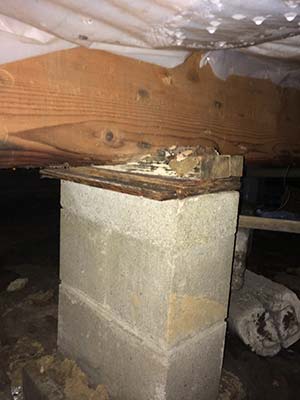High Humidity Levels
When the relative humidity levels below a home are 70% or higher, it can be dangerous. Humidity here, together with moisture and organic materials to feed off of, can contribute to the development of dangerous mold.
Mold only needs three things to survive – water, high levels of humidity, and organic materials (wooden supports, floor joists, etc.). Mold will appear as a dark green or black fungus growing on wooden materials below the home. It can cause many different serious health problems for individuals living in the home, including: asthma attacks, respiratory problems, headaches, severe fatigue, skin rashes, eye irritation, or cold/flu-like symptoms.
Dangers of High Humidity Levels
Along with fostering the development of mold, excessive humidity below the home can also cause wooden materials to warp, rot, and decay. And this includes damage to materials that are necessary when it comes to supporting the weight of a home. This rotting wood can also be very inviting to unwanted critters, including: spiders, snakes, termites, roaches, rats, mice, skunks, or even raccoons. There is no homeowner who wants to have these pests carrying out their entire life cycle below their home, lending to even worse indoor air quality for the rest of the house’s living quarters.
Warning Signs of High Humidity Levels
Below are some indications that dangerous humidity levels are present inside of the crawl space environment:
- Condensation can be seen forming on crawl space vents or access doors.
- Certain areas on the first floor of the home do not feel very level.
- Home smells very musty, similar to dirty gym socks – this can be an indication that mold or mildew has started to grow.
- Mold can actually be seen growing when looking into the crawl space.
- Wood rot and decay can be seen when performing an inspection of the CS environment.
Taking Care of the Problem
To prevent excessive humidity under a home, the crawl space must be sealed off from the outside world. This can be done through crawl space encapsulation.
Encapsulation services will typically involve the installation of several of the following products and systems: dehumidifiers, vapor barriers, floor liners, sump pumps, drainage systems, vents and vent doors, insulation, or other devices. These materials will be able to keep moisture and humidity at bay so that it can’t contribute to additional problems below and inside of the home.


